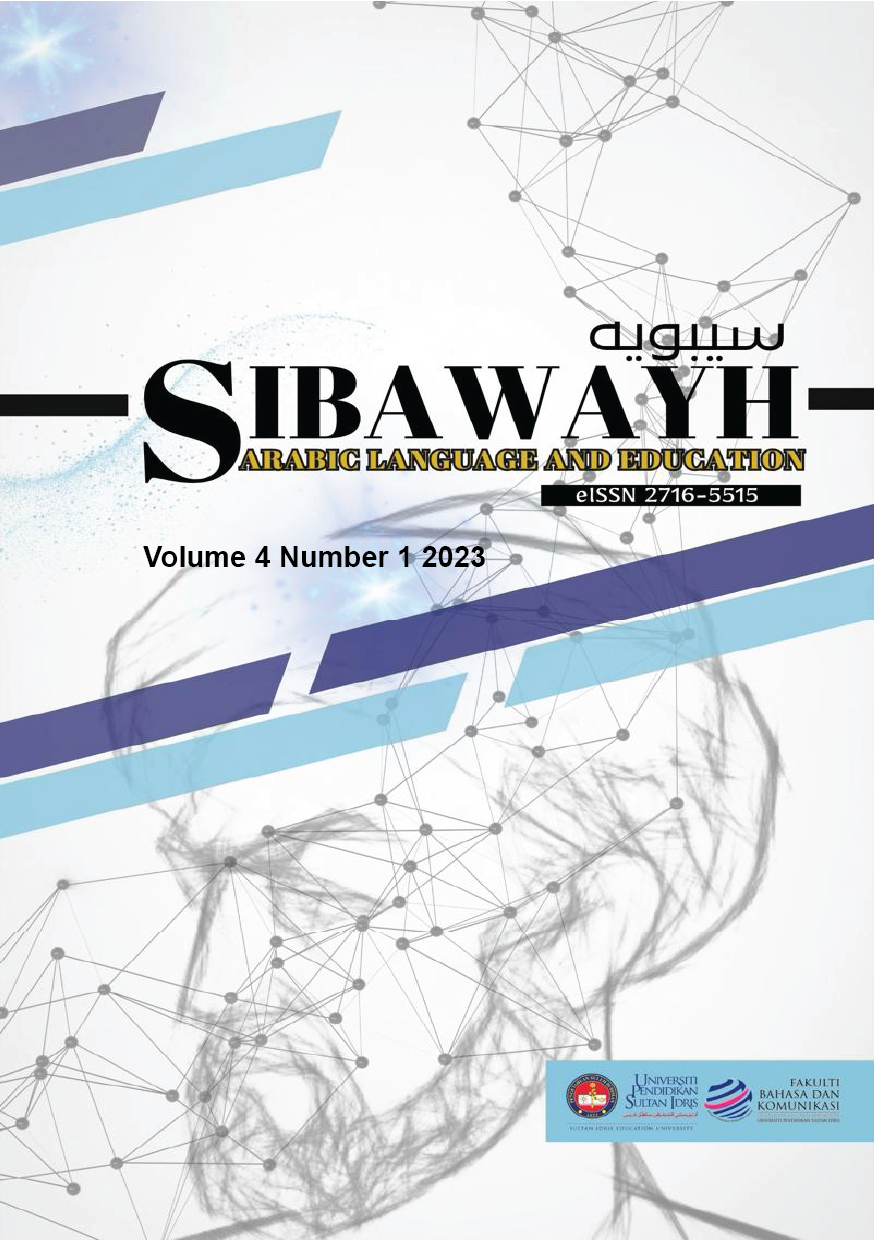العلاقة بين طول الآية وموضوعها: دراسة تطبيقية على سورة البقرة
The Relationship Between the Length of the Qur’anic Verse and Its Subject: An Applied Study on “Surat al-Baqarah”
DOI:
https://doi.org/10.37134/sibawayh.vol4.1.10.2023Keywords:
word symmetry, verse lengthAbstract
تسعى هذه الدراسة لتفسير العلاقة بين طول الآية وموضوعها، وذلك بتطبيق المستوى الثالث من مستويات نظرية المجموعات والتناظر في القرآن الكريم، وهو تناظر الجمل أو الكلمات في الآية الواحدة (بداية مع بداية، وبداية مع نهاية). باستخدام منهجية التحليل والبيان والمقارنة، واستخدم الباحثان الكلمة وحدة لتحليل النصوص القرآنية، وتكون مجتمع الدراسة وعينته من سورة البقرة، واستخدم الباحثان ثلاث قوائم تحليل أدوات للدراسة، وتم استخدام الحاسب الآلي لعد الكلمات وحساب تكراراتها. وتوصلت الدراسة إلى وجود علاقة طردية بين طول الآية وموضوعها، فكلما كانت الآية طويلة تعددت موضوعاتها لعدم اكتمال المعنى، وكلما كانت الآية قصيرة قلت موضوعاتها لاكتمال المعنى. ويوصي الباحثان بإجراء دراسات مشابهة لهذه الدراسة على سور أخرى من القرآن الكريم.
Downloads
References
القرآن الكريم.
أبو زيد، دعاء محمد. (2018). الوحدة الموضوعية في السورة المتعددة القضايا في التفسير الإذاعي للدكتور محمد عبدالله دراز، مجلة كلية التربية - جامعة عين شمس، القاهرة، 24 (2)، ص 115-155.
أبو سويرح، لؤي سعد الدين، و ثابت أحمد أبو الحاج، و أحمد نجيب بن عبدالله. (2021). أثر السياق القرآني في الترجيح بين اختلافات المفسرين" نماذج من سورة التوبة". قرآنيكا، ماليزيا، مج13،ع2، ص 201- 235.
ابن كثير، عماد الدين أبو الفداء. (2000). تفسير القرآن العظيم. (بيروت- لبنان): دار ابن حزم.
الرواجفة، أيمن عيد. (2018 أ). نظرية شبكة التناظر (التناغم) في القرآن الكريم: مبدأ النظرية، مجلة الأطروحة، العراق، مج (3)، عدد (9)، ص1-22.
الرواجفة، أيمن عيد. (2018 ب). نظرية شبكة التناظر في القرآن الكريم اتجاه نحو الابتكار والتجديد، مجلة الأطروحة، العراق، مج (3)، عدد (13)، ص11-26.
الرواجفة، أيمن عيد. (2019). أسرار الترابط في القرآن الكريم : رأي جديد في معاني الحروف المقطعة. مجلة العلوم الإنسانية والاجتماعية، مج ( 3)، ع (5)، ص 62-77.
الرواجفة، أيمن عيد. (2020). نحو نظرية لغوية جديدة لحقبة جديدة: النص من النص والبعد الزائد في تحليل الخطاب، مجلة الاطروحة، مج5، ع5، ص 9-20.
الرواجفة، أيمن عيد. (2022). الاتجاهات المستقبلية في ثلاثية الأبعاد القرآن الكريم والحديث الشريف واللغة العربية: الذهاب إلى أبعد، مجلة المناهل، مج3، ع1، ص 9-28.
الرواجفة، أيمن عيد. و الجبة، منال. (2023). نظرية "النص من النص و البعد الزائد" في تحليل الخطاب النبوي وإعجازه: تطبيق على كتاب الإيمان من صحيح البخاري، مجلة جامعة الحسين بن طلال، مج9،ع1، ص 301-346.
الرواجفة، أيمن عيد. و اليونس، حنان غازي. (2022). استراتيجيات التدريس المتضمنة في سورتي البقرة والمجادلة:" التكامل"، مقبول للنشر في مجلة جامعة الحسين بن طلال.
زهرة، برحيمون فاطمة. (2017). دلالة المتشابه اللفظي في السياقات القرآنية. أطروحة دكتوراه، جامعة جيلالي ليابس/ سيدي بلعباس، الجزائر، ص1-404.
السعدي، عبد الرحمن بن ناصر. (2002). تيسير الكريم الرحمن في كلام المنان. (بيروت- لبنان): مؤسسة الرسالة.
الشعراوي، محمد متولي. (1991). تفسير الشعراوي. (القاهرة - مصر): أخبار اليوم.
صالح، محمد أبو شعالة. (2015). من أسرار التعبير القرآني في سورة الأنفال (دراسة بلاغية تحليلية). أطروحة دكتوراه، جامعة السودان للعلوم والتكنولوجيا، السودان، ص 1-205.
طنطاوي، محمد سيد. (1992). التفسير الوسيط للقرآن الكريم. (القاهرة – مصر): دار المعارف.
عابد، مختارية. (2022). التناظر في القرآن الكريم-دراسة تطبيقية في سورة "النبأ". مجلة المناهل، جامعة عبد الحميد بن باديس- مستغانم. الجزائر، مج3،ع1، ص 124-141.
عظيمي، فضيلة. (2018). التناسب السياقي ومستوياته في تفسير التحرير والتنوير لمحمد الطاهر بن عاشور. أطروحة دكتوراه، جامعة محمد لمين دباغين – سطيف2، الجزائر.
القرطبي، محمد بن أحمد. (2006). الجامع لأحكام القرآن والمبين لما تضمنه من السنة وآي الفرقان. (بيروت- لبنان): مؤسسة الرسالة.
كشي، عفاف. (2017). آيات الحدود والكفارات من خلال سورة المائدة – دراسة موضوعية -. رسالة ماجستير غير منشورة، جامعة الشهيد حمه لخضر- الوادي، معهد العلوم، الإسلامية، الجزائر.
منكل، يارزمان جنت كل. (2011). التكرار في القرآن الكريم (وأسراره البلاغية) في ضوء كتابات علماء العرب وكتابات علماء شبه القارة الهندية (دراسة تطبيقية مقارنة). أطروحة دكتوراه، الجامعة الإسلامية العالمية، إسلام أباد.
المنيفي، أحمد محمد. والرواجفة، أيمن عيد. و اليونس، حنان غازي. (2022). شبكة التناظر (التناغم) في القرآن الكريم: "التناظر الفقهي والقانوني بين سورتي ( الممتحنة والنساء)"، مجلة العاصمة، الهند، مج (14)، ص 296- 302.
اليونس، حنان غازي. والرواجفة أيمن عيد. و القرارعة أحمد عودة. (2022). استراتيجيات التدريس المتضمنة في سورتي البقرة والمجادلة:" التناظر"، مجلة قرآنيكا، ماليزيا، مج14،ع2، ص 85- 119.
Downloads
Published
Issue
Section
License
Copyright (c) 2023 Hanan Ghazi Al-Younes, Ayman Eid Al Rawajfa

This work is licensed under a Creative Commons Attribution-NonCommercial-ShareAlike 4.0 International License.





